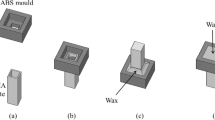Abstract
Spore germination ofBotrytis allii was influenced by the spore concentration and the viscosity of the germination medium. A method was developed for spore germination ofB. allii in a medium without nutrients. Evidence was obtained of the existence of a germination-inhibiting factor which is produced by the germinating cultures. This inhibitor is thermostable and has a low molecular weight.
Similar content being viewed by others
References
Blackman, J.P. (1972) Effectof plant age on inhibition ofBotrytis cinerea spores by bacteria on beet root leaves.Physiol. Pl. Path. 2: 143–152.
Blackman, J.P. (1975) Germination ofBotrytis cinerea conidiain vitro in relation to nutrient conditions on leaf surfaces.Trans. Br. mycol. Soc. 65: 239–247.
Brown, W. (1917) Studies in the physiology of parasitism. IV. On the distribution of cytase in cultures ofBotrytis cinerea.Ann. Bot. (Lond.) 31: 489–498.
Brown, W. (1922) Studies in the physiology of parasitism. VIII. On the exosmosis of nutrient substances from the host into the infection drop.Ann. Bot. (Lond.) 36: 101–119.
Brown, W. (1922) Studies in the physiology of parasitism. IX. The effect on the germination of fungal spores of volatile substances arising from plant tissues.Ann. Bot. (Lond.) 36: 285–300.
Carlile, M.J. and Sellin, M.A. (1963) An endogenous inhibitor of spore germination in fungi.Trans. Br. mycol. Soc. 46: 15–18.
Chet, I. (1977) Germination-inhibitor in slim mouldPhysarum polycephalum. FEMSMicrobiol. Lett. 1: 149–152.
Chou, L.G. (1972) Effect of different concentrations of carbohydrates, amino acids and growth substances on spore germination ofBotrytis cinerea.Phytopathology 62: 1107.
Doran, W.L. (1922) Effect of external and internal factors in the germination of fungous spores.Bull. Torrey Bot. Club 44: 313–336.
Forsyth, F.R. (1955) The nature of the inhibiting substance emitted by germinating uredospores ofPucciniagraminis var.tritici. Can. J. Bot. 33: 363–373.
Haas, P.G. de and Wennemuth, G. (1962) Kühllagerung von Baumschulgehölzen. III.Botrytis -undFusariumbefall an Geholzen im Kühllager.Gartenbauwissenschaft 27: 231–242.
Hawker, L.E. (1966) Germination: morphological and anatomical changes.in: Madulin, M.F. [Ed]. The Fungus Spore. Butterworths Publishers Ltd., London.
Johanson, R. (1954) Anthron in the estimation of hexose sugars, with special reference to pentose interference.Anal. Chem. 26: 1331–1333.
Kritzman, G. and Netzer, D. (1978) A selective medium for isolation and identification ofBotrytis spp. from soil and onion seed.Phytoparasitica 6: 3–7.
Le Roux, P.M. and Dickson, J.G. (1957) Physiology, specialization and genetics ofPuccinia sorghi on corn andPuccinia purpurea on sorghum.Phytopathology 47: 101–107.
Macko, V., Staples, R.C. and Fenwick, H. (1970) Self-inhibitor of bean rust uredospores.Science, N.Y. 170: 539–540.
McKeen, W.E. (1974) Mode of penetration of epidermal cell walls ofVicia faba byBotrytis cinerea.Phytopathology 64: 455.
Schein, R.D. (1964) Comments on the moisture requirements of fungus germination.Phytopathology 54: 1427.
Schütt, P. (1971) Untersuchungen uber den Einfuss von Cuticularwachsen auf die Infektionsfahigkeit pathogener Pilze.I. Lophodermium pinastri undBotrytis cinerea.Eur. J. Path. 1: 32–50.
Shiraishi, M., Fuktomi, M. and Akai, S. (1970) Effects of temperature on the conidium germination and appressorium formation ofBotrytis cinerea.Ann. Phytopath. Soc. Jap. 36: 234–236.
Shiraishi, M., Fuktomi, M. and Akai, S. (1970) Recovery of germinability of aged conidia ofBotrytis cinerea Pers. by several saccharides.Ann. Phytopath. Soc. Jap. 36: 297–303.
Smith, I. (1960) Chromatographic and Electrophoretic Techniques. Vol. I. William Heinemann Medical Books Ltd., London, and Interscience Publishers Inc., New York, NY.
Snow, D. (1949) The germination of mould spores at controlled humidities.Ann. appl. Biol. 36: 1–13.
Stahmann, A.A., Musumeci, M.R. and Morees, W.B.C. (1976) Germination of coffee rust uredospores and their inhibition by cinnamic acid derivatives.Physiol. Biochem. 66: 765–769.
Author information
Authors and Affiliations
Rights and permissions
About this article
Cite this article
Kritzman, G., Gilan, D. & Chet, I. Germination-inhibitor inBotrytis allii spores. Phytoparasitica 8, 73–76 (1980). https://doi.org/10.1007/BF02986237
Received:
Issue Date:
DOI: https://doi.org/10.1007/BF02986237




